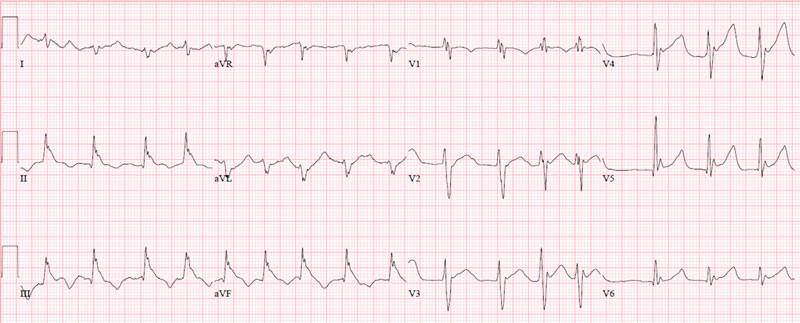Cold Hearted
A. Doran Bostwick, MD
University of Utah School of Medicine
Case
A 20-year-old male was admitted to the ICU after being found down, minimally responsive with severe hypothermia (27 degrees Celsius) following a heroin overdose.
An electrocardiogram was completed.

Question: What is the relevant finding?
J waves
This patient was found to have J waves, atrial fibrillation and a prolonged QTc interval. All of these findings are common in patients with hypothermia. Additionally, severe hypothermia can lead to an absence of P waves and ventricular arrhythmias. A J wave (also referred to as Osborn wave, J deflection, camel hump sign) is a positive deflection (> 1mm) at the end of the QRS complex and must be present in two consecutive beats.1 In hypothermic patients the amplitude of the J wave is inversely proportional to the temperature.2 J waves were first reported in the setting of hypothermia in 1938 and Osborn experimentally induced J waves in hypothermic dogs in 1953.1 The mechanism for J waves is thought to be due to a voltage gradient between the epicardium and endocardium from an outward potassium current that is more prominent in the epicardium. This voltage gradient is accentuated by hypothermia leading to abnormal repolarization.1,3 After rewarming, most cardiac arrhythmias resolve spontaneously though the QT interval prolongation and atrioventricular blocks may persist for days.2
J waves are also seen in conditions besides hypothermia including hypercalcemia, subarachnoid hemorrhage, Brugada syndrome, central nervous system injury, acute ischemic events, and post resuscitation for cardiac arrest.1,2,3
References:
-
Yaganti, Vamsee M., Chetan A. Naik, and Abhay J. Dhond. "Electrocardiographic manifestations in a hypothermic patient: review of Osborn waves." Indian heart journal 59.1 (2007): 80.
-
Aslam, Ahmed Faraz, et al. "Hypothermia: evaluation, electrocardiographic manifestations, and management." The American journal of medicine 119.4 (2006): 297-301.
-
Doshi, Hardik H., and Michael C. Giudici. "The EKG in hypothermia and hyperthermia." Journal of electrocardiology 48.2 (2015): 203-209.



